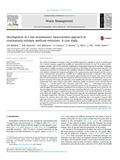JavaScript is disabled for your browser. Some features of this site may not work without it.
| dc.contributor.author | Riddick, Stuart N. | |
| dc.contributor.author | Hancock, B. R. | |
| dc.contributor.author | Robinson, Andrew D. | |
| dc.contributor.author | Connors, Sarah | |
| dc.contributor.author | Davies, S. | |
| dc.contributor.author | Allen, Grant | |
| dc.contributor.author | Pitt, Joseph | |
| dc.contributor.author | Harris, Neil R. P. | |
| dc.date.accessioned | 2017-01-05T11:53:28Z | |
| dc.date.available | 2017-01-05T11:53:28Z | |
| dc.date.issued | 2016-12-18 | |
| dc.identifier.citation | Riddick SN, Hancock BR, Robinson AD, et al., (2018) Development of a low-maintenance measurement approach to continuously estimate methane emissions: a case study. Waste Management, Volume 73, March 2018, pp. 210-219 | en_UK |
| dc.identifier.issn | 0956-053X | |
| dc.identifier.uri | http://dx.doi.org/10.1016/j.wasman.2016.12.006 | |
| dc.identifier.uri | http://dspace.lib.cranfield.ac.uk/handle/1826/11217 | |
| dc.description.abstract | The chemical breakdown of organic matter in landfills represents a significant source of methane gas (CH4). Current estimates suggest that landfills are responsible for between 3% and 19% of global anthropogenic emissions. The net CH4 emissions resulting from biogeochemical processes and their modulation by microbes in landfills are poorly constrained by imprecise knowledge of environmental constraints. The uncertainty in absolute CH4 emissions from landfills is therefore considerable. This study investigates a new method to estimate the temporal variability of CH4 emissions using meteorological and CH4 concentration measurements downwind of a landfill site in Suffolk, UK from July to September 2014, taking advantage of the statistics that such a measurement approach offers versus shorter-term, but more complex and instantaneously accurate, flux snapshots. Methane emissions were calculated from CH4 concentrations measured 700 m from the perimeter of the landfill with observed concentrations ranging from background to 46.4 ppm. Using an atmospheric dispersion model, we estimate a mean emission flux of 709 μg m−2 s−1 over this period, with a maximum value of 6.21 mg m−2 s−1, reflecting the wide natural variability in biogeochemical and other environmental controls on net site emission. The emissions calculated suggest that meteorological conditions have an influence on the magnitude of CH4 emissions. We also investigate the factors responsible for the large variability observed in the estimated CH4 emissions, and suggest that the largest component arises from uncertainty in the spatial distribution of CH4 emissions within the landfill area. The results determined using the low-maintenance approach discussed in this paper suggest that a network of cheaper, less precise CH4 sensors could be used to measure a continuous CH4 emission time series from a landfill site, something that is not practical using far-field approaches such as tracer release methods. Even though there are limitations to the approach described here, this easy, low-maintenance, low-cost method could be used by landfill operators to estimate time-averaged CH4 emissions and their impact downwind by simultaneously monitoring plume advection and CH4 concentrations. | en_UK |
| dc.language.iso | en | en_UK |
| dc.publisher | Elsevier | en_UK |
| dc.rights | Attribution 4.0 International | |
| dc.rights.uri | http://creativecommons.org/licenses/by/4.0/ | |
| dc.subject | Methane | en_UK |
| dc.subject | Landfill | en_UK |
| dc.subject | Low-maintenance | en_UK |
| dc.subject | Measurement | en_UK |
| dc.subject | Emission | en_UK |
| dc.subject | Meteorology | en_UK |
| dc.title | Development of a low-maintenance measurement approach to continuously estimate methane emissions: a case study | en_UK |
| dc.type | Article | en_UK |
Files in this item
This item appears in the following Collection(s)
-
Staff publications (SWEE) [2822]

